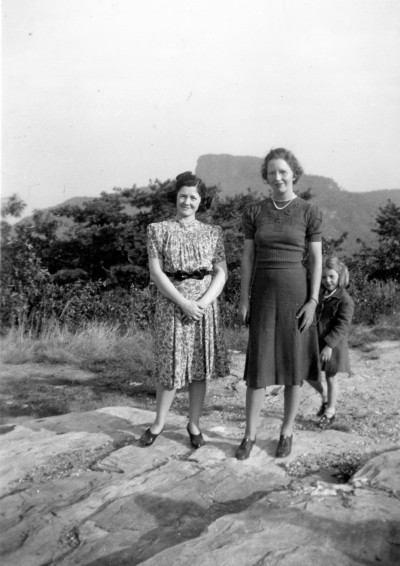The Blue Ridge Parkway leaves each of us with special memories and a deep connection to the mountains. For Doris Luening, that bond was made when she and her family lived near Mount Mitchell as her father and uncle helped build the Blue Ridge Parkway in the 1930s. Here is her story:
Doris Luening was only five years old when she spent a year on the Blue Ridge Parkway, but even today she can direct you straight to the site of the camp that she and her family called home while her father and uncle helped construct the new roadway.
Just north of the entrance to Mount Mitchell State Park, a gate spans the faded road that leads to the spot where a collection of cabins and a bunkhouse once stood. The lodgings were built for the crews who took on the hard work of clearing trees, blasting rock, and moving earth to give shape to what locals called “The Scenic.” Doris’s father, James Erwin Asbury, and uncle, Nesbitte Samuel Asbury, came to the monumental project with Nello Teer Construction Company, which was awarded the first Blue Ridge Parkway construction contract.
James and “Uncle Neb,” as the family called him, were shovel operators, running the complex machines on precarious hillsides to dig out rock and dirt, making way for the paving to come. “In 1935, if you had a job, you were a lucky dog. A lot of people didn’t,” Doris explains. “It was the depths of the Great Depression when this Parkway started. It was a wonderful gift to many people for creating jobs.”
 While the Parkway provided steady work for her dad and uncle from 1935 to 1940, it gave Doris a gift of exploration and adventure. There were plenty of young families on the mountain to form a tight-knit community. “You think of being atop Mount Mitchell as a lonely wild place, and you’re being a wild child,” says Doris, “but there were people to play with there and we did.”
While the Parkway provided steady work for her dad and uncle from 1935 to 1940, it gave Doris a gift of exploration and adventure. There were plenty of young families on the mountain to form a tight-knit community. “You think of being atop Mount Mitchell as a lonely wild place, and you’re being a wild child,” says Doris, “but there were people to play with there and we did.”
She, her parents, and younger sister lived in a three-room cabin heated by a pot belly stove. Her uncle and aunt were just a few cabins away. Doris and her sister named the resident wild turkey “Tom,” and called him their pet, laying out bread crumbs on a stump so they could watch him eat. The kids rode bikes and played with blocks on the floors of each other’s cabins. Doris had special instructions to watch out for snakes to keep her sister safe. When family and friends came to visit their remote outpost, they hiked to the tower atop Mount Mitchell. Doris even remembers visiting the worksite and riding in a dump truck with one of the workers as he released earth over a steep drop off. “It was scary and thrilling,” she says.
The excitement and charm of those times have never left her memory, and in 2014, Doris and her husband, David, established the James Erwin Asbury and Nesbitte Samuel Asbury Endowment to give back to the place that has played an important role in her family’s history.
“My dad and uncle worked on the Parkway for five years, and it was a wonderful time period,” Doris says. “They loved the value of being outside on the Parkway and working, and what it did for the surrounding areas and the people. That’s why we created the endowment. We’d like our family to remember them, and remember that they helped create this park, because it’s a gift to all of us.”
Leave a Legacy
Giving back to the Parkway is a meaningful way to celebrate your personal connection to the journey. In 2014, Doris and David Luening created an endowment to honor her father and uncle. To learn more about how you can leave a legacy, contact Ashley Edwards at (866) 308-2773, ext. 170, or via e-mail.







